Organoids are three-dimensional multicellular in vitro tissue cultures that replicate their in vivo counterparts. As a result of their ability to mimic much of the intricacy of an organ, these cultures are revolutionizing how diseases are investigated and addressed.
Organoid technology has lately risen to prominence as a critical tool for both basic and biomedical research.
Embryonic stem cells (ESCs), induced pluripotent stem cells (iPSCs), and primary tissue can all be used to make organoids. For each type of donor cell used and the type of differentiation desired, various medium components are necessary. Organoid media must contain growth factors such as EGF, R-spondin (RSPO1), Noggin (NOG), HGF, BMP and FGF.
Table 1. Culture Conditions for Organoids from Stem Cells. Source: Cell
| Type of Tissue |
Source |
Stem Cell Culture Condition (niche factors) |
Differentiation Culture Condition |
| Stomach |
Adult mouse |
EGF, Noggin, R-spondin, Wnt-3A, FGF10 |
EGF, R-spondin EGF, R-spondin |
Adult human |
EGF, Noggin, R-spondin, Wnt-3A, FGF10 |
|
hPSC |
EGF |
EGF |
| Small Intestine |
Adult mouse |
EGF, Noggin, R-spondin |
EGF, Noggin, R-spondin |
Adult human |
EGF, Noggin, R-spondin, Wnt-3A TGF-beta inhibitor, p38 inhibitor |
EGF, Noggin, R-spondin, TGF-beta inhibitor |
hPSC |
EGF |
EGF |
| Colon |
Adult mouse |
EGF, Noggin, R-spondin, Wnt-3A |
EGF, Noggin, R-spondin |
Adult human |
EGF, Noggin, R-Spondin, Wnt-3A, TGF-beta inhibitor, p38 inhibitor |
EGF, Noggin, R-spondin, TGF-beta inhibitor |
| Pancreas |
Adult mouse |
EGF, Noggin, R-spondin, Wnt-3A, FGF10, Nicotinamide |
EGF, Noggin, R-spondin, Wnt-3A |
Adult human |
EGF, Noggin, R-spondin, Wnt-3A, FGF10, TGF-beta inhibition, Nicotinamide |
Not reported |
| Liver |
Adult mouse |
EGF, Noggin, R-spondin, Wnt-3A, FGF10, HGF, Nicotinamide |
EGF, Noggin, FGF10, TGF-beta inhibition, Notch inhibition |
Adult human |
EGF, Noggin, R-spondin, Wnt-3A, FGF10, HGF, Nicotinamide, TGF-b inhibitor, Forskolin |
EGF, Noggin, FGF10, TGF-beta inhibition, Notch inhibition, BMP7 |
To allow optimum and consistent organoid development, Sino Biological has created an array of recombinant growth factors with excellent bioactivity, batch-to-batch consistency and purity.
Recombinant growth factor proteins for organoid culture
Sino Biological has created bioactive recombinant growth factors from a variety of animals, including humans, rhesus, mice, rats, cynomolgus and dogs.
Featured EGF protein
Human EGF protein: 10605-HNAE
- High-purity
- Tag-free
- HPLC-verified
- Low-endotoxin
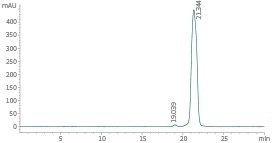
> 95 % as determined by SEC-HPLC. Image Credit: Sino Biological Inc.
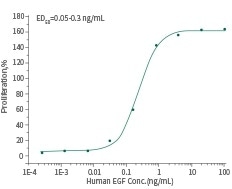
A cell proliferation assay using Balb/C 3T3 mouse embryonic fibroblasts. Image Credit: Sino Biological Inc.
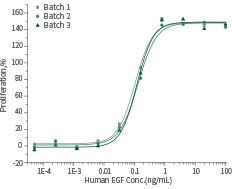
Batch-to-batch Consistency. Image Credit: Sino Biological Inc.
Other featured growth factors
Recombinat HGF proteins
Human HGF protein | 10463-HNAS
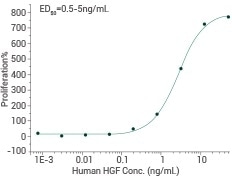
Ability to neutralize TGF-beta mediated inhibition on Mv-1-Lu cell proliferation. Image Credit: Sino Biological Inc.
Cynomolgus HGF protein | 90286-CNAH
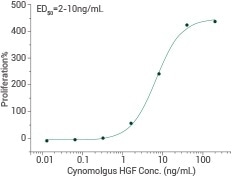
Ability to inhibit TGFβ1 activity on Mv-1-lu mink lung epithelial cells. Image Credit: Sino Biological Inc.
Human FGF10 protein | 10573-HNAE
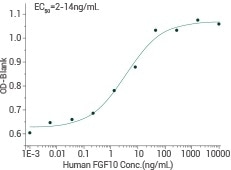
Cell proliferation assay using BaF3 mouse proB cells transfected with human FGFR2b. Image Credit: Sino Biological Inc.
Human noggin/NOG protein | 10267-HNAH
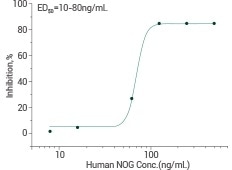
Ability to inhibit BMP4-induced alkaline phosphatase production by MC3T3E1 mouse preosteoblast cells. Image Credit: Sino Biological Inc.
Human RSPO1 protein | 11083-HNAS
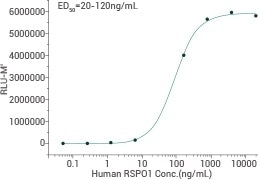
Ability to induce activation of ßcatenin response in a Topflash Luciferase assay using HEK293T human embryonic kidney cells. Image Credit: Sino Biological Inc.
Human BMP-2 protein | 10426-HNAE
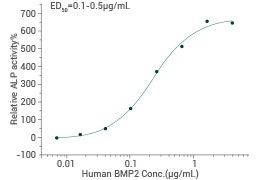
Ability to induce alkaline phosphatase production by MC3T3-E1 mouse osteoblastic cells. Image Credit: Sino Biological Inc.
Learn more about recombinant growth factors for organoid culture.